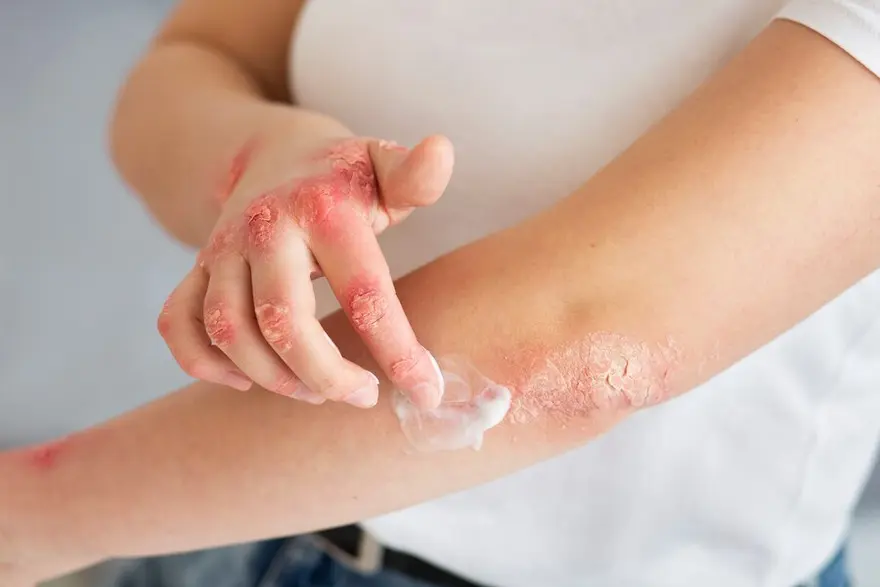Preventive Healthcare
Everything You Need To Know About Impetigo
5256 Views
0

What is Impetigo?
Impetigo is a common bacterial infection of the skin. It can affect anyone but is most commonly found in children with sensitive skin conditions or adults with weakened immune systems and diseases like diabetes.
Impetigo causes the formation of sores and blisters that appear differently depending on the stage of the infection and the part of the body it affects. Impetigo is a highly contagious skin disease caused by bacteria like Streptococcus pyogenes that affect the epidermis (outer layer of the skin). The Impetigo bacteria often enters the body through open cuts, insect bites, or other rashes. However, there have been rare cases in children who showed impetigo symptoms even when they had no prior injury or breakage of skin.
Impetigo often occurs in warmer months when children play outside.
What are the types of Impetigo?
There are three major impetigo types, including:
Non-bullous Impetigo
This is the earliest stage of Impetigo and the most common type. This stage of Impetigo is characterised by
- developing one or multiple impetigo sores that itch and quickly burst
- the skin that has broken open will appear red or raw
- glands near these sores are often swollen
- a honey-coloured crust forms over the impetigo sores, but this skin quickly heels without leaving any scars
Bullous Impetigo
This is rarer than Impetigo and is more commonly found in infants. Approximately 90% of all bullous impetigo cases can be found in children below the age of two years. This type of Impetigo is identified with:
- Large, fluid-filled blisters on the child's skin
- Blisters that have become clean and limp before breaking open
- Crust formation over the sores
Ecthyma
When any of the above impetigo types are left untreated, they can evolve into ecthyma. This kind of Impetigo infection goes deeper into the child's skin, and the stages involve:
- Painful blisters that form deep open sores
- development of thick crusts on the skin with redness around the infected area
- lingering scars even after the epidermis has healed because the Impetigo infection seeps more deeply into the skin
What are the symptoms of Impetigo?
Initial impetigo symptoms include the formation of discoloured sores on your child's skin, which can be found in clusters around the nose and lips. The impetigo rash appears red or pink on lighter skin tones, while darker skin tones get a dark red, purple, brown, or grey rash.
The Impetigo sores proliferate into more prominent blisters that can ooze, burst, and form a yellowish crust. These clusters of Impetigo blisters can also expand and cover more area on the skin.
Impetigo sores are often itchy and painful and can form discoloured marks once the crust phase is completed.
What are the causes of Impetigo?
Certain types of bacteria, such as Staphylococcus aureus (which causes 80% of non-bullous impetigo cases) and group A streptococcus (which causes 10% of non-bullous Impetigo instances), are the main Impetigo causes.
Impetigo infection may occur when one of the bacteria mentioned above enters the child's body through a scrape, cut, insect bite, or rash. Once the bacteria enters the body, impetigo symptoms may appear as inflammation on the skin. Impetigo can also occur when your child scratches some form of rash, like chickenpox or eczema, where the skin breaks, giving way for the bacteria to enter.
Impetigo in adults occurs because of breakage in the skin, as mentioned above, and other health conditions, such as tattoo infections, scabies, and herpes.
Is Impetigo contagious?
Impetigo is a highly contagious disease that can be caught through skin-to-skin contact. You may develop symptoms if you come in contact with open sores, nasal discharge, or mucus of someone infected with Impetigo. This is one of the most common Impetigo causes in children and athletes. Sharing personal items like clothing or towels can also cause the spread of the disease.
What are the risk factors?
Impetigo can develop in anyone, but certain groups of people are more susceptible to impetigo infections. These include children and adults who:
- live in places that are humid and warm
- stay in crowded places for more extended periods, like daycare centres, schools or training facilities
- have compromised immune systems
- have diabetes
- suffer from skin conditions like dermatitis, psoriasis, or eczema
- have insect bites or rash from poison ivy
- have itchy infections like scabies, herpes simplex, or lice
Age is another important risk factor, as Impetigo is more common among kids between 2 and 5.
What are the complications of Impetigo?
Impetigo is a mild infection; it may turn serious if left untreated for an extended period. Following infections and harmful immune responses are the main impetigo complications:
- Soft tissue infection
- Toxic shock syndrome
- Rheumatic fever
- Staphylococcal scalded skin syndrome
Adults pose a higher risk of complications related to Impetigo, including:
- Cellulitis
- Sepsis
- Lymphangitis
- Acute post-streptococcal glomerulonephritis
How is Impetigo diagnosed?
You may be diagnosed with Impetigo based on how the skin sores look. A skin sample may be sent to the labs for a skin culture, which helps confirm the diagnosis and determine the right antibiotic for the infection.
How do you treat Impetigo?
Antibiotics are the most common option for impetigo treatment. Your healthcare provider will prescribe topical impetigo therapy, in which an antibiotic ointment is applied directly to the child's skin. However, if the infection has spread to a larger portion of the skin, you may also need to take oral impetigo medication like cephalosporins, sulfamethoxazole, or clindamycin.
When to see a doctor?
Minor Impetigo infections can go away on their own; however, if the infection develops into deeper or more serious wounds and punctures, you may need to see a doctor.
Can I prevent Impetigo?
Maintaining good hygiene is one of the best ways to prevent Impetigo infection. Regular baths and hand washing can reduce the amount of bacteria on your skin. The best way to avoid the spread of the rash is to cover the area with an open Impetigo wound or bug bite. Keep your nails clean and clipped, avoid scratching open sores that can cause the spread of the infection, and wash everything that comes in contact with the impetigo sores.
Conclusion
Impetigo is a highly contagious skin condition caused by bacteria. Most cases can heal independently without impetigo treatment, by taking the proper precautions and following good hygiene. However, more severe impetigo symptoms may require you to visit a doctor and get a skin culture to determine the impetigo cause, followed by a treatment plan. Metropolis Labs India is the leading diagnostic service that provides convenient at-home and in-lab tests. Contact us today to set up your appointment.























 WhatsApp
WhatsApp